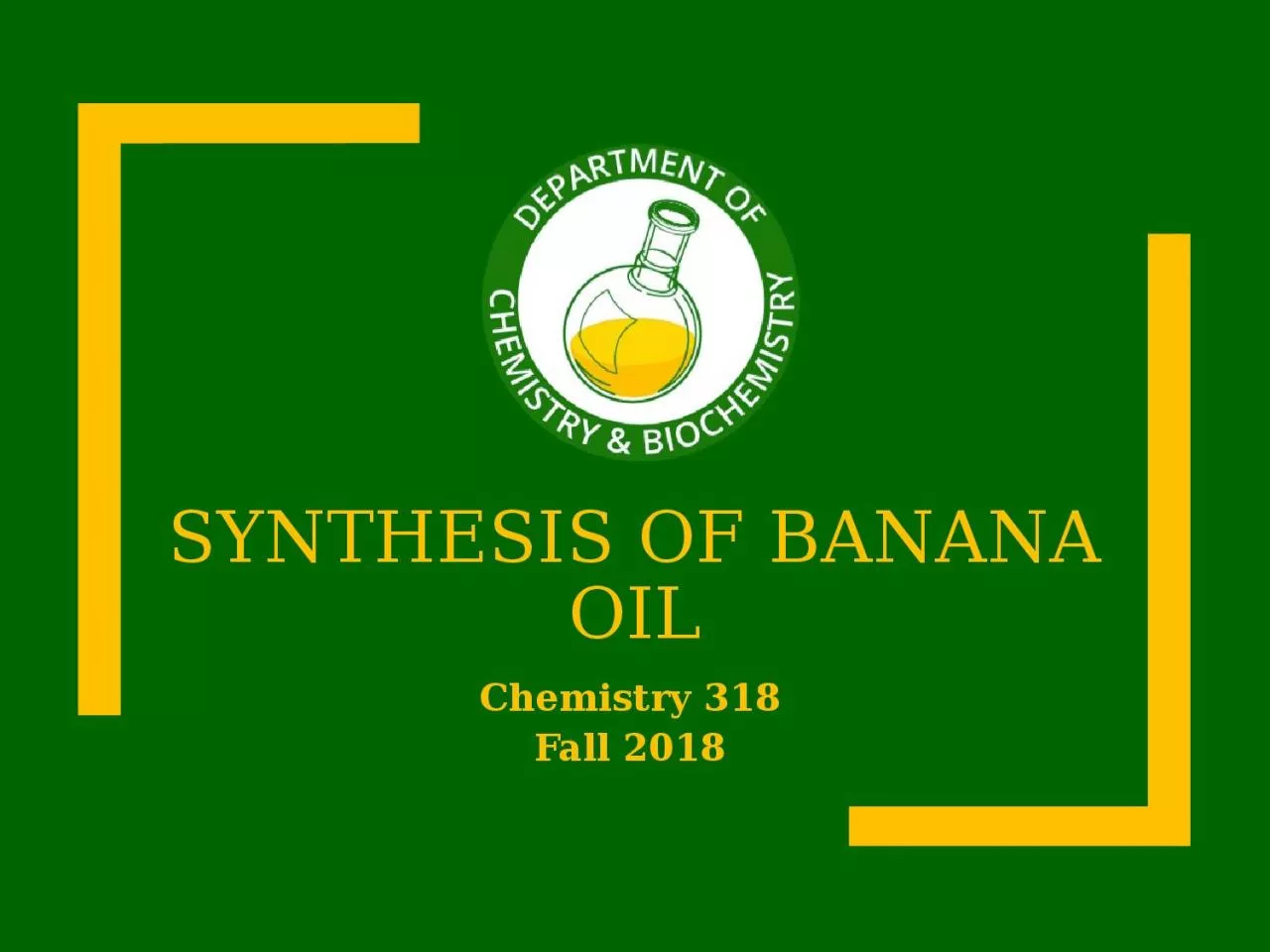

Fall 2018 Schedule of day PPE check at the door Prelab check at the door Quiz Recitation Synthesis of Banana Oil Safety Put bags away Goggles Gloves Lab Coat LAB Due Dates ID: 918468
Download Presentation The PPT/PDF document "Synthesis of Banana Oil Chemistry 318" is the property of its rightful owner. Permission is granted to download and print the materials on this web site for personal, non-commercial use only, and to display it on your personal computer provided you do not modify the materials and that you retain all copyright notices contained in the materials. By downloading content from our website, you accept the terms of this agreement.
Slide1
Synthesis of Banana Oil
Chemistry 318Fall 2018
Slide2Schedule of
day
PPE check – at the door
Pre-lab check – at the door
Quiz
Recitation
Synthesis of Banana Oil
Safety
Put bags away
Goggles
Gloves
Lab Coat
LAB!
Slide3Due Dates
Today
At beginning of lab
- Aldehydes and Ketones Report
For instructions, see Notebook & Report Formats for Unknown ID in Bb
End
of lab –
yellow Notebook
pages (Synthesis of banana oil
).
Next
Week
Synthesis of
Banana Oil Report
F
or
instructions, see Notebook & Report Formats for
Synthesis reports
in
Bb
.
Slide4Synthesis
of Isoamyl Acetate (Banana Oil)
Carboxylic acid + alcohol
→
ester + H
2
O
The reaction is acid-catalyzedMuch too slow in the absence of H+The reaction is an equilibrium reactionEquilibrium must be shifted to favor productAcetic acid used in excess
Slide5Synthesis of
Isoamyl Acetate
Mechanism:
nucleophilic acyl
substitution
2 main reaction steps:
1) addition, and
2) elimination
overall substitution
Slide6Synthesis of
Isoamyl Acetate
The
H
2
SO
4
catalyst can protonate both the alcohol and the acetic acid.The alcohol –OH is a stronger base than the >C=O of the carboxyl group
Slide7Synthesis of
Isoamyl Acetate
The H
+
is transferred to the oxygen of the carboxyl
group,
which makes the C=O more
electrophilic.After the alcohol attacks the protonated carboxyl in the addition step, a new bond is formed in the tetrahedral intermediate
Slide8Synthesis of
Isoamyl Acetate
The tetrahedral intermediate has protons removed and added by other bases and acids in solution
Slide9Synthesis of
Isoamyl Acetate
The
oxonium
ion
–OH
2
+
is a good leaving group.The carbon-oxygen bond breaksThe cation that results is stabilized by resonance with both oxygens (only one resonance contributor shown)
Slide10Synthesis of
Isoamyl Acetate
The proton is removed by
bases that are present
, such as the alcohol (ROH) or the carboxylic acid (RCO
2
H
) or water (H
2O).The product is the ester and the byproduct is waterThe acid catalyst is regenerated and the cycle continues…
Slide11Experiment
Notes
Reflux apparatus
Liquid boils in round bottom flask
Vapors
ascend into the condenser
The cold inside glass condenses the vapor to a liquid, which drips back into the flask
Slide12Experiment
Notes
Have reflux apparatus ready, but add liquids to flask
away
from heat source
Weigh vial +
isopentyl
alcohol Pour alcohol into RBF using a funnel Re-weigh empty vial Measure volume of acetic acid using grad. cylinder and add to RBF Add 1 ml H2SO4 and SWIRL the flask to mix
Slide13Experiment
NotesAssemble the reflux apparatus – let me check it before you move on!
Remember drying tube and boiling stones!
Heat to boiling for 60
minutes.
Then
, cool to room
temperature.
Slide14Separation of Product
Extract
organic layer
first with water.
Then extract
with
5% NaHCO
3
(aq.). CAUTION: gas build-up in funnel – vent after every shake.What does sodium bicarbonate extract?Finally, extract organic layer with saturated NaCl (aq.).
Slide15Separation of Product
Always
keep the upper organic layer in the separatory
funnel.
Drain the lower aq. layers into the beaker (combined
aqueous waste).
After the last extraction, pour the organic layer through the
top
of the funnel into a small Erlenmeyer flask.
Slide16Separation of Product
Add Na
2
SO
4
as drying agent (anhydrous
).
After absorbing H2O from the organic layer, it becomes the hydrated salt Na2SO4 ∙ nH2O After ester is dried, transfer (decant) liquid to a small vial.Take refractive index and
IR.